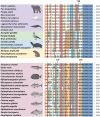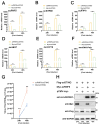Ring finger protein 5 mediates STING degradation through ubiquitinating K135 and K155 in a teleost fish
- PMID: 39723209
- PMCID: PMC11668637
- DOI: 10.3389/fimmu.2024.1525376
Ring finger protein 5 mediates STING degradation through ubiquitinating K135 and K155 in a teleost fish
Abstract
Stimulator of interferon genes (STING) is a key connector protein in interferon (IFN) signaling, crucial for IFN induction during the activation of antiviral innate immunity. In mammals, ring finger protein 5 (RNF5) functions as an E3 ubiquitin ligase, mediating STING regulation through K150 ubiquitylation to prevent excessive IFN production. However, the mechanisms underlying RNF5's regulation of STING in teleost fish remain unknown. This study investigated the regulatory role of the mandarin fish (Siniperca chuatsi) RNF5 (scRNF5) in the STING-mediated antiviral immune response and identified the specific regulatory sites on scSTING. Furthermore, an examination of scRNF5 expression patterns in virus-infected cells revealed its responsiveness to mandarin fish ranavirus (MRV) infection. The ectopic expression of scRNF5 suppressed scSTING-mediated IFN signaling and facilitated MRV replication. Co-immunoprecipitation experiments indicated an interaction between scRNF5 and scSTING. The further experiments demonstrated that scRNF5 exerted its inhibitory effect by promoting the degradation of scSTING, which was observed to be blocked by MG132 treatment. Ubiquitination assays with various scSTING mutants showed that scRNF5 catalyzed the ubiquitination of scSTING at K135 and K155 residues. Furthermore, we provided evidence that scRNF5 significantly attenuated scSTING-dependent antiviral immunity by targeting negative regulators within the scSTING signaling cascade. This study underscored that RNF5 negatively regulated the STING-mediated IFN signaling pathway in mandarin fish, attenuated STING's antiviral activity, and facilitated STING degradation via the ubiquitin-proteasome pathway at two novel lysine sites (K135 and K155). Our work offered valuable insights into the regulatory mechanisms of STING-mediated signaling in teleost fish, paving the way for further research.
Keywords: RNF5; STING; innate immunity; interferons; ubiquitination.
Copyright © 2024 Qin, Li, Liang, Qian, You, Weng, He and Guo.
Conflict of interest statement
The authors declare that the research was conducted in the absence of any commercial or financial relationships that could be construed as a potential conflict of interest.
Figures









Similar articles
-
RNF122 targets STING for ubiquitination at residues K95, K117, and K155 to regulate antiviral responses in a teleost fish.Zool Res. 2025 Jul 18;46(4):750-760. doi: 10.24272/j.issn.2095-8137.2025.033. Zool Res. 2025. PMID: 40567163
-
The roles of mandarin fish STING in innate immune defense against Infectious spleen and kidney necrosis virus infections.Fish Shellfish Immunol. 2020 May;100:80-89. doi: 10.1016/j.fsi.2020.02.062. Epub 2020 Mar 2. Fish Shellfish Immunol. 2020. PMID: 32135344
-
The Interaction of Mandarin Fish DDX41 with STING Evokes type I Interferon Responses Inhibiting Ranavirus Replication.Viruses. 2022 Dec 24;15(1):58. doi: 10.3390/v15010058. Viruses. 2022. PMID: 36680100 Free PMC article.
-
[Research progress on the regulation of innate immunity by RING finger proteins].Xi Bao Yu Fen Zi Mian Yi Xue Za Zhi. 2024 Sep;40(9):844-848. Xi Bao Yu Fen Zi Mian Yi Xue Za Zhi. 2024. PMID: 39442974 Review. Chinese.
-
RNF5: inhibiting antiviral immunity and shaping virus life cycle.Front Immunol. 2024 Jan 5;14:1324516. doi: 10.3389/fimmu.2023.1324516. eCollection 2023. Front Immunol. 2024. PMID: 38250078 Free PMC article. Review.
Cited by
-
Bacterial effector screening reveals RNF214 as a virus restriction factor in mammals.PLoS Pathog. 2025 Apr 22;21(4):e1013035. doi: 10.1371/journal.ppat.1013035. eCollection 2025 Apr. PLoS Pathog. 2025. PMID: 40261845 Free PMC article.
References
MeSH terms
Substances
LinkOut - more resources
Full Text Sources
Research Materials

